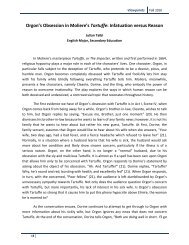Acid Ionization Constant (K a ) of an Indicator - Quantum - East ...
Acid Ionization Constant (K a ) of an Indicator - Quantum - East ...
Acid Ionization Constant (K a ) of an Indicator - Quantum - East ...
Create successful ePaper yourself
Turn your PDF publications into a flip-book with our unique Google optimized e-Paper software.
<strong>Acid</strong> <strong>Ionization</strong> <strong>Const<strong>an</strong>t</strong> (K a ) <strong>of</strong> <strong>an</strong> <strong>Indicator</strong><br />
2014, Sharmaine S. Cady<br />
<strong>East</strong> Stroudsburg University<br />
Skills to build:<br />
Using a micropipette<br />
Using acid-base equilbria principles<br />
Preparing buffers with specific pH values<br />
Using spectrophotometry to determine K a<br />
Introduction<br />
<strong>Indicator</strong>s are usually weak org<strong>an</strong>ic acids <strong>an</strong>d bases that are partially ionized in<br />
water. If HIn represents the general formula for <strong>an</strong> indicator, then the ionization reaction<br />
is<br />
HIn(aq) + H 2 O(l)<br />
H 3 O + (aq) + In - (aq)<br />
According to Le Châtelier's principle, the above equilibrium shifts from left to right (or<br />
right to left) as the pH <strong>of</strong> the solution ch<strong>an</strong>ges. If the pH <strong>of</strong> a solution containing HIn is<br />
increased (increase in base concentration), the H 3 O + concentration decreases <strong>an</strong>d the<br />
equilibrium shifts to the right. The solution will ch<strong>an</strong>ge from the color <strong>of</strong> HIn to the color<br />
<strong>of</strong> In - . The opposite is true if the pH <strong>of</strong> the solution is decreased.<br />
Bromocresol purple (1) <strong>an</strong>d its sodium salts (2, 3) are indicator dyes that are<br />
yellow below a pH <strong>of</strong> 5.2 (In - pure present) <strong>an</strong>d purple above a pH <strong>of</strong> 6.8 (pure In 2-<br />
present). Between 5.2 <strong>an</strong>d 6.8 (tr<strong>an</strong>sition r<strong>an</strong>ge), both HIn <strong>an</strong>d In - are present at various<br />
concentrations. The wavelength <strong>of</strong> maximum absorb<strong>an</strong>ce for bromocresol purple at pH<br />
5.2 is 427-431 nm <strong>an</strong>d 588-590 nm at pH 6.8.<br />
1 2 3
<strong>Acid</strong> <strong>Ionization</strong> <strong>Const<strong>an</strong>t</strong><br />
The ionization reaction in aqueous solution c<strong>an</strong> be written<br />
Br<br />
O<br />
Br<br />
O<br />
CH 3<br />
CH 3<br />
H 3 C<br />
H 3 C<br />
HO<br />
–<br />
O<br />
S<br />
O<br />
+ H2O H3O + +<br />
–<br />
O<br />
–<br />
O<br />
S<br />
O<br />
Br<br />
O<br />
Br<br />
O<br />
yellow<br />
purple<br />
The equilibrium const<strong>an</strong>t, or acid ionization const<strong>an</strong>t (K a ), for <strong>an</strong> indicator is given<br />
by the following expression<br />
[ ][ ]<br />
[ ]<br />
This equation for the above reaction is<br />
[ ][ ]<br />
[ ]<br />
The [H 3 O + ] c<strong>an</strong> easily be measured with a pH meter. The ratio <strong>of</strong> [In - ]/[HIn] c<strong>an</strong> be<br />
determined spectrophotmetrically as long as the amount <strong>of</strong> total indicator remains<br />
const<strong>an</strong>t in all solutions used to measure absorb<strong>an</strong>ce. Under these conditions, the<br />
following is true<br />
[total indicator]=[HIn] + [In - ]<br />
Let represent the fraction <strong>of</strong> the total indicator amount that is In - . We c<strong>an</strong> then<br />
write this fraction as<br />
[In ]<br />
<br />
[totalindicaotr]<br />
This equation c<strong>an</strong> be rearr<strong>an</strong>ged to give [In - ] = [total indicator].<br />
<br />
2
<strong>Acid</strong> <strong>Ionization</strong> <strong>Const<strong>an</strong>t</strong><br />
If is the fraction that is In - , then the remaining fraction that is HIn is 1 - We<br />
c<strong>an</strong> then write its fraction as<br />
[HIn]<br />
1 <br />
[totalindicaotr]<br />
This equation rearr<strong>an</strong>ges to give [HIn] = (1 - )[total indicator]. Substituting these values<br />
for [In - ] <strong>an</strong>d [HIn] into the equation for K a gives<br />
[totalindicator]<br />
<br />
[H<br />
(1<br />
)[totalindicator]<br />
Ka<br />
3<br />
C<strong>an</strong>cellation <strong>of</strong> the [total indicator] terms yields<br />
<br />
[H<br />
(1<br />
)<br />
K a<br />
3<br />
O<br />
<br />
]<br />
O<br />
<br />
]<br />
We measure the [H 3 O + ] with a pH meter. We only need the value for to solve for K a .<br />
We will use visible spectrophotometry to determine .<br />
At very high pH, the ionization equilibrium shifts far to the right <strong>an</strong>d we c<strong>an</strong><br />
assume that the entire indicator is in its In - form. At high pH, [total indicator] = [In - ] pure .<br />
Absorb<strong>an</strong>ce is directly proportional to the concentration <strong>of</strong> In - , therefore, we c<strong>an</strong><br />
substitute A pure for [In - ] pure . At pH values in the tr<strong>an</strong>sition r<strong>an</strong>ge, [In - ] is a fraction () <strong>of</strong><br />
[In - ] pure , or [In - ] = [In - ] pure . Absorb<strong>an</strong>ce values (A) in this r<strong>an</strong>ge measure [In - ]. This c<strong>an</strong><br />
be represented in equation form as<br />
<br />
[In ] A<br />
<br />
<br />
[In ]<br />
pure<br />
A pure<br />
You will prepare five solutions <strong>of</strong> bromocresol purple at different pH values <strong>an</strong>d measure<br />
their absob<strong>an</strong>ces. Solution 1 will have a value one pH unit above the tr<strong>an</strong>sition r<strong>an</strong>ge.<br />
Solutions 2-5 will have pH values that sp<strong>an</strong> the center <strong>of</strong> the tr<strong>an</strong>sition r<strong>an</strong>ge. You<br />
should work out these pH values <strong>an</strong>d record them in your notebook prior to class. To<br />
see the results for the indicator dye phenolphthalein, read the sample experiment<br />
problem.<br />
3D Molecules<br />
Go to the web site <strong>an</strong>d click on the Bromocresol Purple molecule. Use the<br />
radio buttons to show different views <strong>an</strong>d properties <strong>of</strong> each molecule. Answer the<br />
questions based on the m<strong>an</strong>ipulation <strong>of</strong> the molecules.<br />
3
<strong>Acid</strong> <strong>Ionization</strong> <strong>Const<strong>an</strong>t</strong><br />
Experimental Methods <strong>an</strong>d Materials<br />
Safety considerations<br />
Wear suitable protective clothing, gloves, <strong>an</strong>d eye/face protection!<br />
You should read the online MSDS for:<br />
Ammonium Chloride Phosphoric <strong>Acid</strong> Sodium Hydroxide<br />
Bromocresol Purple<br />
Sodium Citrate<br />
Preparation <strong>of</strong> solutions<br />
Label 5 cle<strong>an</strong>, dry stoppered Erlenmeyer flasks. Obtain 50 mL <strong>of</strong> the stock<br />
buffer in a beaker. The buffer contains sodium citrate, phosphoric acid, <strong>an</strong>d ammonium<br />
chloride dissolved in water. Measure the pH. Add 0.1 M NaOH to adjust its pH to the<br />
lowest value you selected in the tr<strong>an</strong>sition r<strong>an</strong>ge. Micropipette 5.0000 mL <strong>of</strong> this buffer<br />
solution into the flask labeled Solution 5. Adjust the remaining buffer solution in the<br />
beaker to the next lowest pH value with NaOH. Micropipette 5.0000 mL into the flask<br />
labeled Solution 4. Continue to prepare the next three solutions in a similar m<strong>an</strong>ner.<br />
Make sure your record the exact pH <strong>of</strong> each solution. With a micropipette, add 130 L<br />
<strong>of</strong> bromocresol purple solution to each flask.<br />
4
<strong>Acid</strong> <strong>Ionization</strong> <strong>Const<strong>an</strong>t</strong><br />
Calibrating the Vernier Spectrophotometer<br />
Click on Logger Pro from the Programs list on the computer. Click on<br />
Experiment Calibrate Spectrometer on the menu bar. Allow the spectrometer to<br />
warm up for 3 minutes. Place a cuvette ¾ full with distilled water in the cuvette holder.<br />
Click Finish Calibration. Once the OK button is ready, click it.<br />
Collecting data for <br />
Fill a cuvette ¾ full with Solution 1. Place in the cuvette holder. Click on the<br />
Configure Spectrometer Data Collection icon on the right-h<strong>an</strong>d side <strong>of</strong> the menu<br />
bar. Click Abs. vs. Concentration under Set Collection Mode. Click the OK button to<br />
close the dialog box. Check that the wavelength for absorb<strong>an</strong>ce shown along the y-axis<br />
is a close match to max for bromocresol purple. If not, recalibrate. This absorb<strong>an</strong>ce is<br />
A pure .<br />
Click on the Collect button at the top right <strong>of</strong> the menu bar. Record the<br />
absorb<strong>an</strong>ce shown in red inside the box below the data table. Hit the Stop button.<br />
Insert Solution 2 into the cuvetter holder. Hit Collect. Record the absorb<strong>an</strong>ce value.<br />
Hit Stop. Repeat absorb<strong>an</strong>ce data collection for Solutions 3-5.<br />
Laboratory Report<br />
The following should be part <strong>of</strong> your final report:<br />
Determine for Solutions 2-5.<br />
Determine [H 3 O + ] from the pH for Solutions 2-5.<br />
Calculate K a for Solutions 2-5. Calculate <strong>an</strong> average K a . Calculate the st<strong>an</strong>dard<br />
deviation for K a . Both the average <strong>an</strong>d st<strong>an</strong>dard deviation may be done in Excel.<br />
Compare your K a to the accepted literature value. Explain <strong>an</strong>y signific<strong>an</strong>t error.<br />
5








